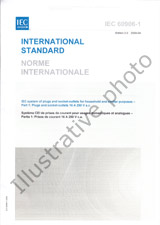We need your consent to use the individual data so that you can see information about your interests, among other things. Click "OK" to give your consent.

IEC 62555-ed.1.0
Ultrasonics - Power measurement - High intensity therapeutic ultrasound (HITU) transducers and systems
STANDARD published on 19.11.2013
The information about the standard:
Designation standards: IEC 62555-ed.1.0
Publication date standards: 19.11.2013
SKU: NS-414757
The number of pages: 113
Approximate weight : 370 g (0.82 lbs)
Country: International technical standard
Category: Technical standards IEC
The category - similar standards:
Annotation of standard text IEC 62555-ed.1.0 :
IEC 62555:2013 establishes general principles relevant to HITU fields for the use of radiation force balances in which an obstacle (target) intercepts the sound field to be measured; specifies a calorimetric method of determining the total emitted acoustic power of ultrasonic transducers based on the measurement of thermal expansion of a fluid-filled target; specifies requirements related to the statement of electrical power characteristics of ultrasonic transducers; provides guidance related to the avoidance of acoustic cavitation during measurement; provides guidance related to the measurement of HITU transducers of different construction and geometry, including collimated, diverging and convergent transducers, and multi-element transducers; provides guidance on the choice of the most appropriate measurement method; and provides information on assessment of overall measurement uncertainties. This International Standard is applicable to the measurement of ultrasonic power generated by HITU equipment up to 500 W in the frequency range from 0,5 MHz to 5 MHz. HITU equipment may generate convergent, collimated or divergent fields. For frequencies less than 500 kHz, no validations exist and the user should assess the uncertainties of the power measurement and measurement system at the frequencies of operation. This International Standard does not apply to ultrasound equipment used for physiotherapy, for lithotripsy for general pain relief. La IEC 62555:2013 etablit les principes generaux, applicables aux champs HITU, permettant dutiliser les balances de forces de rayonnement dans lesquelles un obstacle (cible) intercepte le champ acoustique a mesurer; specifie une methode calorimetrique de determination de la puissance acoustique totale emise par des transducteurs ultrasonores, en se fondant sur le mesurage de la dilatation thermique dun fluide cible; specifie les exigences relatives a la declaration des caracteristiques de la puissance electrique des transducteurs ultrasonores; fournit des recommandations permettant deviter la cavitation acoustique au cours du mesurage; donne des lignes directrices pour le mesurage des transducteurs HITU de differentes constructions et geometries, y compris les transducteurs non focalisants, divergents et focalisants ainsi que les transducteurs a elements multiples; fournit des recommandations quant au choix de la methode de mesurage la plus appropriee; et fournit des informations concernant levaluation des incertitudes de mesure globales. La presente Norme Internationale sapplique au mesurage de la puissance ultrasonore generee par des appareils HITU, atteignant jusqua 500 W, dans la gamme des frequences de 0,5 MHz a 5 MHz. Les appareils HITU peuvent generer des champs focalises, non focalises ou divergents. Il nexiste aucune validation pour les frequences inferieures a 500 kHz. Il convient que lutilisateur evalue les incertitudes de mesure de la puissance et du systeme de mesure aux frequences de fonctionnement utilisees. La presente Norme internationale ne sapplique pas aux appareils a ultrasons utilises pour la physiotherapie, pour la lithotritie ou pour soulager la douleur de maniere generale.
We recommend:
Technical standards updating
Do you want to make sure you use only the valid technical standards?
We can offer you a solution which will provide you a monthly overview concerning the updating of standards which you use.
Would you like to know more? Look at this page.



 Cookies
Cookies
